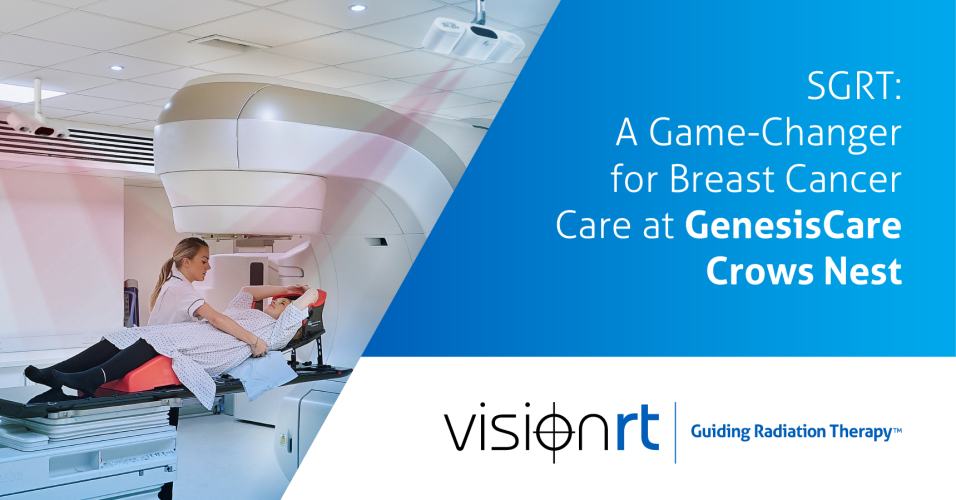SGRT: A Game-Changer for Breast Cancer Care at GenesisCare Crows Nest

The pursuit of the highest level of patient care is the ultimate goal of cancer centers worldwide. For GenesisCare Crows Nest in Sydney, Australia, this meant adopting new technologies that would enhance treatment accuracy and patient experience. In 2018, they made a transformative decision to integrate AlignRT for breast cancer treatments and later for every patient, every fraction.
Before implementing SGRT, the center relied on snorkel-based breath-hold systems. While functional, these systems had limitations. « Our main objective was to find a breath-hold solution that improved the snorkel-based systems we had been using. We were looking for something that could directly interface with the Linac and, most importantly, be minimally invasive for the patients. SGRT emerged as the primary solution for that need, especially for DIBH (Deep Inspiration Breath Hold), » explains Mark Wanklyn, Senior Medical Physics Specialist at GenesisCare Crows Nest.
The decision to adopt SGRT was also heavily influenced by their staff attending an SGRT Community conference in Sydney. » We saw a presentation on going tattooless and the benefits it could achieve. This coupled with knowing that GenesisCare sites in the UK had already successfully done this gave us the confidence to adopt SGRT and the first commitment was to go tattooless, » says Mark.
The Benefits of a Tattooless Approach
One of the standout features of SGRT, particularly AlignRT, is its contactless, non-invasive nature. The technology tracks a patient’s position before and during radiation therapy with sub-millimetric accuracy, ensuring the radiation is delivered exactly as planned. By incorporating this system, GenesisCare Crow’s Nest was able to offer an alternative to the permanent tattoo markings traditionally used to ensure treatment accuracy.
« It’s a significant draw for patients,” says Mark. « By eliminating tattoos, we remove the associated infection risks, as well as various work health and safety concerns. » He adds. For some patients’, tattoos are a painful experience and become a lifelong reminder of their cancer treatment: « Of course, patients will always remember that they had cancer; that feeling never fully goes away. But not having to face a daily reminder can help them move forward and put it behind them, » says Mark.
On the reaction from clinicians and patients, Mark says: “The response has been overwhelmingly positive. One consultant mentioned that a patient came to her with a severe needle phobia, and being tattooless allowed her to undergo treatment without the need for anxiety medication. This has really set us apart as a tattooless department, and we’ve had many patients choose us specifically because of this ».
He goes on to note that « the workflow improvements SGRT has provided, such as better couch positioning, have made the process much more hands-off. »
Improving Workflows and Reducing Treatment Times
In addition to patient comfort, SGRT has led to significant improvements in workflow efficiency and treatment accuracy. « SGRT has definitely improved our workflows and reduced the need for repeat imaging, ensuring the patient is consistently in the correct position. With the older RPM box system, patients would have to arch their back slightly to align the block. Now, with SGRT, we have multiple data points on the patient’s surface, allowing for much more accurate treatments, » Mark explains.
« Our treatment times have definitely decreased, especially since we’ve implemented the center couch setup for our breast patients. We’ve seen about a 26% reduction in treatment time for standard breast treatments. We’re now treating those patients in around 12 minutes, with some cases taking between 12 and 18 minutes depending on the complexity. It’s been a significant improvement, » he says.
SGRT has also streamlined the setup process. « It allows us to check, before any imaging, that the patient can reliably reproduce the breath hold. With a quick visual look at the patient’s contours, we can confirm alignment. The setup process has become much faster with Postural Video imaging, as we can clearly see all the outlines and details that need to align. This has been a big positive for us, » Mark adds.
Expanding Beyond Breast Treatments
Since the implementation of SGRT in breast cancer treatments, in 2018, the team at GenesisCare Crows Nest has expanded its use across other treatment areas. « It’s implemented for every patient, for every fraction, » says Mark, underscoring the versatility and value of this technology in modern radiation therapy.
Worldwide there are 65 AlignRT systems across 63 GenesisCare sites. With reduced treatment times, enhanced precision, and a more patient-friendly approach, GenesisCare continues to lead the way in offering cutting-edge care to breast cancer patients and beyond. As technology evolves, SGRT is proving to be an invaluable tool in the ongoing fight against cancer.